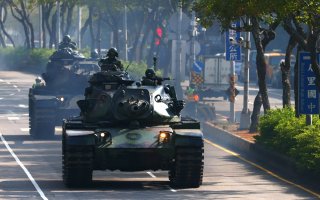Meet the 4 Most Produced Tanks in Human History
These tanks had sheer numerical superiority.
Here's What You Need to Know: These powerful weapon platforms fought on battlefields across the globe.
Tanks have rolled across the battlefields of the world for more than 100 years, and since their introduction at the Battle of the Somme in 1916 the platform has changed the way armies could mount and conduct offensives. Despite that fact, the United States Marine Corps has retired its tanks, while the British Army has also scaled back its tank force—tanks will remain a critical component for militaries for decades to come.
And even as the debate over the “best” and even the “worst” is unlikely to be settled anytime soon, there was the issue of numerical superiority. A few tanks stand out simply for being the most produced of their respective generation.
French Renault FT
The French Army wasn’t the first to develop a tank during the “Great War,” but where their British allies sought to build the massive heavy tanks, which had a crew of eight; French designer Jean-Baptiste Estienne went another direction. He believed that a smaller, more maneuverable tank produced in the hundreds could overwhelm the enemy.
The result was the Renault FT, a light tank that had a crew of just two. Its configuration with a fully rotating turret with main gun was the forerunner of tank development to come. During the First World War France produced more than 3,000 of the tanks—compared to just twenty A7V heavy tanks employed by Germany. Copies of the FT were made by the United States, Italy and the Soviet Union, making it one of the most produced models of tanks until the outbreak of the Second World War. Today some forty are in museums and private collections.
American M4 Sherman
The Sherman certainly wasn’t the best tank of the Second World War, but with more than 50,000 produced between 1942 and 1945 it was the most commonly used American tank of the war. It was also the only tank to be used in all combat theaters, while it was also employed by Great Britain, the Free French, China, Canada and even the Soviet Union.
The Sherman proved itself effective against the German Panzer IIIs and Panzer IVs, but as anyone who has seen the film Fury knows, it was outclassed by the Tiger—as well as the Panther and King Tiger. However, the Sherman was easier to maintain and the United States produced them in what proved to be overwhelming numbers. During the Cold War, the M4 Sherman also saw extensive use around the world, holding its own against more modern armor.
While only a handful of Tigers survive, there are still hundreds of Shermans that can been seen in museums while there are even dozens in private collections. These robust tanks continue to regularly come up for auction, and one sold in November 2020 for around $400,000. It is easy to see why these remain the ultimate WWII collectable.
American M60
This was most produced American tank of the Cold War, and it wasn’t just the U.S. Army that used them to their full potential; the M60 Patton also saw service in the armies of twenty-two countries. It first entered service in 1959 and has been steadily upgraded and improved over the years. Even today, the M60 remains in use with some seventeen nations—a testament to the robustness of the design. A total of 15,000 were built—and most were the improved M60A1, which featured thicker armor and an upgraded ammunition stowage system.
The United States Army retired its M60A3s in 1997, but around 1,700 are still in use with the Egyptian Army, while Turkey and Israel operate around 900 and 700 of the tanks respectively.
Soviet T-54/55
The T-54 series of tanks were introduced in the late 1940s to replace the T-34 that was used throughout World War II. As the basic version was continuously improved and modified, the Soviet military redesignated it the T-55. Upwards of 100,000 T-54/T-55 tanks were produced between 1946 and 1983, making this series the most widely manufactured tank in history.
During the Cold War, Soviet tanks never directly faced the North Atlantic Treaty Organization in combat; however the T-54/55 was used by Syria in the Six Day War against Israel, where the American M48 Patton and British Centurion tanks proved more than capable against the Soviet-built armor. In the 1970s the T-54/55 also saw combat in Vietnam, Cambodia and Uganda. The tank model was widely exported and remains in use around the world with some fifty armies today, even as it has replaced by more modern tanks in the Russian Army.
Peter Suciu is a Michigan-based writer who has contributed to more than four dozen magazines, newspapers and websites. He regularly writes about military small arms, and is the author of several books on military headgear including A Gallery of Military Headdress, which is available on Amazon.com.
This article first appeared in March 2021.
Image: M60 tanks in Taiwan / REUTERS / Ann Wang

